
Snorkeling
Encyclopedia
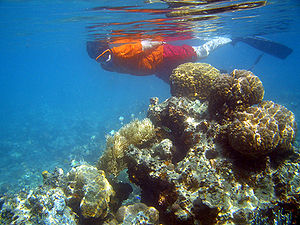
Diving mask
A diving mask is an item of diving equipment that allows scuba divers, free-divers, and snorkelers to see clearly underwater. When the human eye is in direct contact with water as opposed to air, its normal environment, light entering the eye is refracted by a different angle and the eye is unable...
, a shaped tube called a snorkel, and usually swimfins. In cooler waters, a wetsuit
Wetsuit
A wetsuit is a garment, usually made of foamed neoprene, which is worn by surfers, divers, windsurfers, canoeists, and others engaged in water sports, providing thermal insulation, abrasion resistance and buoyancy. The insulation properties depend on bubbles of gas enclosed within the material,...
may also be worn. Use of this equipment allows the snorkeler to observe underwater attractions for extended periods of time with relatively little effort.
Snorkeling is a popular recreation
Recreation
Recreation is an activity of leisure, leisure being discretionary time. The "need to do something for recreation" is an essential element of human biology and psychology. Recreational activities are often done for enjoyment, amusement, or pleasure and are considered to be "fun"...
al activity, particularly at tropical
Tropics
The tropics is a region of the Earth surrounding the Equator. It is limited in latitude by the Tropic of Cancer in the northern hemisphere at approximately N and the Tropic of Capricorn in the southern hemisphere at S; these latitudes correspond to the axial tilt of the Earth...
resort
Resort
A resort is a place used for relaxation or recreation, attracting visitors for holidays or vacations. Resorts are places, towns or sometimes commercial establishment operated by a single company....
and scuba diving
Scuba diving
Scuba diving is a form of underwater diving in which a diver uses a scuba set to breathe underwater....
locations. The primary appeal is the opportunity to observe underwater life in a natural setting without the complicated equipment and training required for scuba diving and it appeals to all ages because of how little effort there is, and without the exhaled bubbles of scuba-diving equipment.
Snorkeling is also employed by scuba divers when on the surface, and search and rescue
Search and rescue
Search and rescue is the search for and provision of aid to people who are in distress or imminent danger.The general field of search and rescue includes many specialty sub-fields, mostly based upon terrain considerations...
teams may snorkel as part of a water-based search. It is also a means to an end in popular sports such as underwater hockey
Underwater hockey
Underwater hockey is a global non-contact sport in which two teams compete to maneuver a puck across the bottom of a swimming pool into goals.-Play:...
, underwater ice hockey
Underwater ice hockey
Underwater ice hockey is a minor extreme sport that is a variant of ice hockey. It is played upside-down underneath frozen pools or ponds. Participants wear wetsuits and flippers, and use the underside of the frozen surface as the playing area for a floating puck...
, underwater rugby
Underwater rugby
Underwater rugby is a sport that has its origin in the physical fitness training of German diving clubs and has little in common with rugby football except for the name....
and spearfishing
Spearfishing
Spearfishing is an ancient method of fishing that has been used throughout the world for millennia. Early civilizations were familiar with the custom of spearing fish from rivers and streams using sharpened sticks....
.
The snorkel
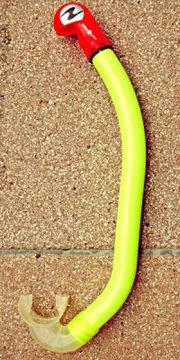
Mouthpiece (scuba)
In breathing sets, a mouthpiece is a part that the user grips in his mouth, to make a watertight seal between the breathing set and his mouth. It is composed of a short flattened-oval tube that goes in between the lips, with on its free end a flange that fits between the lips and the tooth and gums...
at the lower end, and constructed of rubber
Rubber
Natural rubber, also called India rubber or caoutchouc, is an elastomer that was originally derived from latex, a milky colloid produced by some plants. The plants would be ‘tapped’, that is, an incision made into the bark of the tree and the sticky, milk colored latex sap collected and refined...
or plastic
Plastic
A plastic material is any of a wide range of synthetic or semi-synthetic organic solids used in the manufacture of industrial products. Plastics are typically polymers of high molecular mass, and may contain other substances to improve performance and/or reduce production costs...
. It is used for breathing air from above the water surface when the wearer's mouth and nose are submerged. The snorkel usually has a piece of rubber
Rubber
Natural rubber, also called India rubber or caoutchouc, is an elastomer that was originally derived from latex, a milky colloid produced by some plants. The plants would be ‘tapped’, that is, an incision made into the bark of the tree and the sticky, milk colored latex sap collected and refined...
that attaches the snorkel to the outside of the strap of the diving mask
Diving mask
A diving mask is an item of diving equipment that allows scuba divers, free-divers, and snorkelers to see clearly underwater. When the human eye is in direct contact with water as opposed to air, its normal environment, light entering the eye is refracted by a different angle and the eye is unable...
. An older technique is pushing the snorkel between the mask-strap and the head, but this practice increases the chances the mask will leak.
The most common type of snorkel is a simple tube that is allowed to flood when underwater
Underwater
Underwater is a term describing the realm below the surface of water where the water exists in a natural feature such as an ocean, sea, lake, pond, or river. Three quarters of the planet Earth is covered by water...
. The snorkeler expels water from the snorkel either with a sharp exhalation on return to the surface (blast clearing) or by tilting the head back shortly before reaching the surface and exhaling until reaching or "breaking" the surface (displacement method) and facing forward again before inhaling the next breath. The displacement method expels water by displacing its presence in the snorkel with air; it is a more advanced technique that takes practice but clears the snorkel with much greater efficiency.
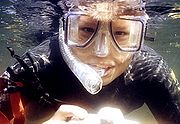
Sump
A sump is a low space that collects any often-undesirable liquids such as water or chemicals. A sump can also be an infiltration basin used to manage surface runoff water and recharge underground aquifers....
in the mouthpiece to allow a small volume of water to remain in the snorkel without being inhaled when the snorkeler breathes. Some also have a one-way output valve
Valve
A valve is a device that regulates, directs or controls the flow of a fluid by opening, closing, or partially obstructing various passageways. Valves are technically pipe fittings, but are usually discussed as a separate category...
in the sump
Sump
A sump is a low space that collects any often-undesirable liquids such as water or chemicals. A sump can also be an infiltration basin used to manage surface runoff water and recharge underground aquifers....
, which automatically drains the sump
Sump
A sump is a low space that collects any often-undesirable liquids such as water or chemicals. A sump can also be an infiltration basin used to manage surface runoff water and recharge underground aquifers....
as it fills with water. A few snorkels have float-operated valves attached to the top end of the tube to keep water out when the snorkeler submerges, and more recent designs have a splash deflector on the top end that directs any water that splashes over the open tube to the outside of the tube, thereby keeping the user's mouth free from water.
Some snorkels used to be made with small "ping pong" balls in a cage
Cage (enclosure)
A cage is an enclosure made of mesh, bars or wires, used to confine, contain or protect something or someone. A cage can serve many purposes, including keeping an animal in captivity, capturing, and being used for display of an animal at a zoo.-History:...
mounted to the open end of the tube to prevent water ingress, but these are no longer sold nor recommended to be used since they are considered hazardous to the snorkeler. Similarly, diving mask
Diving mask
A diving mask is an item of diving equipment that allows scuba divers, free-divers, and snorkelers to see clearly underwater. When the human eye is in direct contact with water as opposed to air, its normal environment, light entering the eye is refracted by a different angle and the eye is unable...
s with a snorkel built into them are considered unsafe and obsolete.
The optimum design length of the snorkel tube is at most 40 centimetres (about 16 inches). A longer tube would not allow breathing when snorkelling deeper, since it would place the lung
Lung
The lung is the essential respiration organ in many air-breathing animals, including most tetrapods, a few fish and a few snails. In mammals and the more complex life forms, the two lungs are located near the backbone on either side of the heart...
s in deeper water where the surrounding water pressure
Pressure
Pressure is the force per unit area applied in a direction perpendicular to the surface of an object. Gauge pressure is the pressure relative to the local atmospheric or ambient pressure.- Definition :...
is higher. The lungs would then be unable to inflate when the snorkeler inhales, because the muscle
Muscle
Muscle is a contractile tissue of animals and is derived from the mesodermal layer of embryonic germ cells. Muscle cells contain contractile filaments that move past each other and change the size of the cell. They are classified as skeletal, cardiac, or smooth muscles. Their function is to...
s that expand the lungs are not strong enough to operate against the higher pressure. Snorkels also create what is called "dead air space" – when the user takes in a fresh breath, some of the previously exhaled air remains in the snorkel and is recycled into the lungs, reducing breathing efficiency and causing hypercapnia
Hypercapnia
Hypercapnia or hypercapnea , also known as hypercarbia, is a condition where there is too much carbon dioxide in the blood...
, a build up of carbon dioxide in the blood. The greater the volume in the device, the more this problem is exacerbated.
The dive mask
Snorkelers normally wear the same kind of mask as those worn by scuba divers. By creating an airspace, the mask enables the snorkeler to see clearly underwater. All scuba diving masks consist of the lenses also known as a faceplate, a comfortable skirt, which also encloses the nose, and a head strap. There are different styles and shapes. These range from oval shaped models to lower internal volume masks and may be made from different materials; common choices are silicone and rubber.The practice of snorkeling
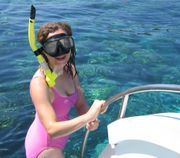
Reef
In nautical terminology, a reef is a rock, sandbar, or other feature lying beneath the surface of the water ....
, wreck
Wreck
Wreck may refer to:* Wreck, a ceremony of initiation into the 40 et 8 club* Wreck , an American indie rock band* A collision of an automobile, aircraft or other vehicle* Shipwreck, the remains of a ship after a crisis at sea...
, or other submerged objects, either to observe aquatic organisms including fish
Fish
Fish are a paraphyletic group of organisms that consist of all gill-bearing aquatic vertebrate animals that lack limbs with digits. Included in this definition are the living hagfish, lampreys, and cartilaginous and bony fish, as well as various extinct related groups...
, algae
Algae
Algae are a large and diverse group of simple, typically autotrophic organisms, ranging from unicellular to multicellular forms, such as the giant kelps that grow to 65 meters in length. They are photosynthetic like plants, and "simple" because their tissues are not organized into the many...
, etc. or to look at rock formations. Being non-competitive, snorkeling is considered more a leisure activity than a sport
Sport
A Sport is all forms of physical activity which, through casual or organised participation, aim to use, maintain or improve physical fitness and provide entertainment to participants. Sport may be competitive, where a winner or winners can be identified by objective means, and may require a degree...
.
Snorkeling requires no special training, only the ability to swim and to breathe through the snorkel. However, for safety reasons, instruction and orientation from a fellow "experienced" snorkeler, tour guide, dive shop, or equipment-rental shop is recommended. Instruction generally covers equipment usage, basic safety, what to look for, and what to look out for, and conservation instructions (fragile organisms such as coral
Coral
Corals are marine animals in class Anthozoa of phylum Cnidaria typically living in compact colonies of many identical individual "polyps". The group includes the important reef builders that inhabit tropical oceans and secrete calcium carbonate to form a hard skeleton.A coral "head" is a colony of...
are easily damaged by divers and snorkelers). As with scuba-diving it is always recommended that one not snorkel alone, but rather with a "buddy
Buddy diving
Buddy diving is the use of the buddy system by scuba divers and is a set of safety procedures that are intended to improve divers' chances of avoiding or surviving accidents in or under water by diving in a group of two or three divers...
", a guide
Guide
A guide is a person who leads anyone through unknown or unmapped country. This includes a guide of the real world , as well as a person who leads someone to more abstract places .-Guide - meanings related to travel and recreational pursuits:There are many variants of...
or a tour group.
Some commercial snorkeling locations require snorkelers to wear an inflatable vest, similar to a personal flotation device
Personal flotation device
A personal flotation device is a device designed to assist a wearer, either conscious or unconscious, to keep afloat.Devices designed and approved by authorities for use by...
. They are usually bright yellow or orange
Orange (colour)
The colour orange occurs between red and yellow in the visible spectrum at a wavelength of about 585–620 nm, and has a hue of 30° in HSV colour space. It is numerically halfway between red and yellow in a gamma-compressed RGB colour space, the expression of which is the RGB colour wheel. The...
and have a device that allows users to inflate or deflate the device to adjust their buoyancy. However these devices hinder and prevent a snorkeler from free diving to any depth. Especially in cooler water, a wetsuit of appropriate thickness and coverage may be worn; wetsuits do provide some buoyancy without as much resistance to submersion. In the tropics, snorkelers (especially those with pale skin) often wear a rashguard or a shirt and/or board shorts in order to help protect the skin of the back and upper legs against sunburn.
Experienced snorkelers often start to investigate amateur free-diving
Free-diving
Freediving is any of various aquatic activities that share the practice of breath-hold underwater diving. Examples include breathhold spear fishing, freedive photography, apnea competitions and, to a degree, snorkeling...
, which should be preceded by at least some training from a dive instructor or experienced free-diver.
Safety precautions
The greatest danger to snorkelers are small inshore and leisure crafts such as jet skis, speed boats and the like. A snorkeler is often submerged in the water with only the tube visible above. Since these crafts can ply the same areas snorkelers visit, the chance for accidental collision exists. Sailboats and windsurfers are especially worrisome as their quiet propulsion systems means the snorkeler may be unaware of their presence, unlike any motor-driven craft, as sound travels farther underwater. A snorkeler may surface under one and/or be struck by such vessels. Few places demarcate small craft areas from snorkelers, unlike for regular bathers who may have areas marked by buoys. Snorkelers may therefore choose to wear bright or highly reflective colors/outfits and/or to employ dive flags to ease being spotted by boaters and others.Snorkelers' backs can be exposed to the sun for extended periods and can burn badly (even if slightly submerged), without being noticed. Wearing appropriate covering such as a "rash guard" (in warmer waters), a t-shirt, a wetsuit and/or sunblock will mitigate the risk of sunburn.
Dehydration is another concern. Hydrating well before going in is recommended, especially if one intends to snorkel for several hours. Proper hydration also prevents cramps.
Snorkelers can experience hyperventilation
Hyperventilation
Hyperventilation or overbreathing is the state of breathing faster or deeper than normal, causing excessive expulsion of circulating carbon dioxide. It can result from a psychological state such as a panic attack, from a physiological condition such as metabolic acidosis, can be brought about by...
, which can lead in turn to “shallow water blackout
Shallow water blackout
A shallow water blackout is a loss of consciousness caused by cerebral hypoxia towards the end of a breath-hold dive in water typically shallower than five metres , when the swimmer does not necessarily experience an urgent need to breathe and has no other obvious medical condition that might have...
″; snorkeling with a buddy (and being aware of the buddy's condition at all times) can help avoid this situation.
When snorkeling on or near coral reef
Coral reef
Coral reefs are underwater structures made from calcium carbonate secreted by corals. Coral reefs are colonies of tiny living animals found in marine waters that contain few nutrients. Most coral reefs are built from stony corals, which in turn consist of polyps that cluster in groups. The polyps...
s, care must be exercised to avoid contact with the delicate (and sometimes sharp and/or stinging) coral and its poisonous inhabitants, usually via protective gloves and by being careful of one's environment. Booties and surf shoes are especially useful as they allow trekking over reefs exposed by low tide, to drop offs or deeper waters of the outer reef.
Also, for ecological reasons, contact with coral always should be avoided because even boulder corals are fragile. A soft touch can cause decades worth of growth to be undone in mere seconds, and the coral may never recover.
Snorkeling locations
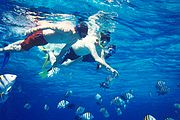
Generally shallow reefs ranging from sea level to 1 to 4 meters (3 to 12 feet) are favored by snorkelers. Deeper reefs are also good, but repeated breath holding to dive to those depths limit the number of practitioners and raises the bar on fitness and skill level.
Variants and related activities
- Bog snorkellingBog snorkellingBog snorkelling is a sporting event that consists of competitors completing two consecutive lengths of a water filled trench cut through a peat bog, in the shortest time possible. Competitors must wear snorkels and flippers, and complete the course without using conventional swimming strokes,...
: An individual sportSportA Sport is all forms of physical activity which, through casual or organised participation, aim to use, maintain or improve physical fitness and provide entertainment to participants. Sport may be competitive, where a winner or winners can be identified by objective means, and may require a degree...
, popular in the United KingdomUnited KingdomThe United Kingdom of Great Britain and Northern IrelandIn the United Kingdom and Dependencies, other languages have been officially recognised as legitimate autochthonous languages under the European Charter for Regional or Minority Languages...
and AustraliaAustraliaAustralia , officially the Commonwealth of Australia, is a country in the Southern Hemisphere comprising the mainland of the Australian continent, the island of Tasmania, and numerous smaller islands in the Indian and Pacific Oceans. It is the world's sixth-largest country by total area...
. - Free-divingFree-divingFreediving is any of various aquatic activities that share the practice of breath-hold underwater diving. Examples include breathhold spear fishing, freedive photography, apnea competitions and, to a degree, snorkeling...
: Any form of diving without breathing apparatus, but often referring to competitive apneaApneaApnea, apnoea, or apnœa is a term for suspension of external breathing. During apnea there is no movement of the muscles of respiration and the volume of the lungs initially remains unchanged...
as a sport. - Scuba divingScuba divingScuba diving is a form of underwater diving in which a diver uses a scuba set to breathe underwater....
: A form of untethered diving using a self contained portable breathing apparatus, frequently as a pastime. - SnubaSnubaSnuba is an underwater breathing system developed by Snuba International.The word Snuba is a portmanteau of "snorkel" and "scuba". The swimmer uses swimfins, a diving mask, weights, and diving regulator as in scuba diving....
: Trade name for an underwater swimming system using air supplied from the surface. - SpearfishingSpearfishingSpearfishing is an ancient method of fishing that has been used throughout the world for millennia. Early civilizations were familiar with the custom of spearing fish from rivers and streams using sharpened sticks....
: Fishing with a spearSpearA spear is a pole weapon consisting of a shaft, usually of wood, with a pointed head.The head may be simply the sharpened end of the shaft itself, as is the case with bamboo spears, or it may be made of a more durable material fastened to the shaft, such as flint, obsidian, iron, steel or...
often with snorkelling equipment, either for competitive sport or to obtain food. - Underwater hockeyUnderwater hockeyUnderwater hockey is a global non-contact sport in which two teams compete to maneuver a puck across the bottom of a swimming pool into goals.-Play:...
: A competitive team-sport played in swimming poolSwimming poolA swimming pool, swimming bath, wading pool, or simply a pool, is a container filled with water intended for swimming or water-based recreation. There are many standard sizes; the largest is the Olympic-size swimming pool...
s using snorkelling equipment, stickHockey stickA hockey stick is a piece of equipment used in field hockey, ice hockey or roller hockey to move the ball or puck.- Field hockey :Field hockey sticks have an end which varies in shape, often depending on the players position...
s and a puckPuck (sports)A puck is a disk used in various games serving the same functions as a ball does in ball games. The best-known use of pucks is in ice hockey, a major international sport.- Etymology :The origin of the word "puck" is obscure...
. - Underwater rugbyUnderwater rugbyUnderwater rugby is a sport that has its origin in the physical fitness training of German diving clubs and has little in common with rugby football except for the name....
: A competitive team-sport played in deeper swimming poolSwimming poolA swimming pool, swimming bath, wading pool, or simply a pool, is a container filled with water intended for swimming or water-based recreation. There are many standard sizes; the largest is the Olympic-size swimming pool...
s using snorkelling equipment, baskets and a ballBallA ball is a round, usually spherical but sometimes ovoid, object with various uses. It is used in ball games, where the play of the game follows the state of the ball as it is hit, kicked or thrown by players. Balls can also be used for simpler activities, such as catch, marbles and juggling...
.
External links
- British Sub-Aqua Club site on snorkeling
- How to Snorkel
- National Parks Conservation Association page on snorkeling Earliest known patent for snorkel.

